sierraclub.org - sierra magazine - may/june 2010 - addicts and enablers


Addicts & Enablers
China remains wedded to dirty coal, despite huge investments in clean energy. When its own supplies lag, other nations are happy to feed its need.
By Adam Minter
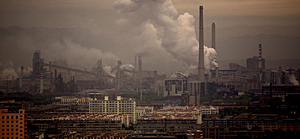
The face of China's economic miracle: a power plant
in Taiyuan burning high-sulfur coal.
Fly into Taiyuan, China, in the winter, and you will likely descend through an orange cloud. Taiyuan is the capital of Shanxi province, and Shanxi is the heart of China's coal country. The region's sulfur-heavy coal bathes the city and countryside in a sherbet-colored haze, making it difficult to distinguish the distant power plants from the towns and villages that dot the mountain landscape. During my last visit, I exited a hotel elevator to find even the farthest reaches of the hallway tinted ginger.
The next morning, when I walked outside to find breakfast, I passed storefronts where stoves--small and large--were fueled by piles of the locally mined rock. Behind those storefronts, coal-fired heaters warmed the back rooms where the shopkeepers live. In Shanxi, filthy coal is a part of daily life, providing a cheap, readily available source of energy that won't be replaced by renewables or reduced via conservation efforts anytime soon.
Shanxi is located in China's vast west, and most of the energy it generates is transmitted east, to Beijing and coastal cities whose residents are as addicted to coal as Taiyuan's shopkeepers are. Coastal Shanghai's expanding stock of high-rise condos, for example, are built without insulation, which minimizes construction costs but requires residents to use far more energy for heating than their counterparts in the developed world. The buildings, explains Rich Brubaker, founder of Collective Responsibility, a China-based nongovernmental organization, are essentially cement blocks, "and before you can really feel warm, you basically have to heat the cement."
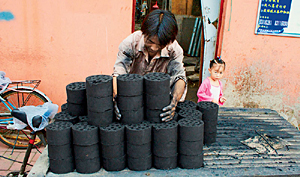
Coal bricks to fuel stoves in Beijing.
Buildings account for well over half of China's energy demands, and total Chinese floor space is expected to more than double over the next 20 years, so Taiyuan's haze is certain to thicken. Will Latta, managing director of LP Amina, which manufactures pollution equipment for coal plants in the United States and China, estimates that fewer than 5 percent of Chinese coal-fired plants have equipment to reduce or eliminate nitrogen oxide, the main contributor to smog. "They're 15 to 20 years behind the U.S.," he says.
By one estimate, China was responsible for 85 percent of the worldwide growth in coal demand last year, and what it didn't obtain by mining the world's third-largest known reserves, it imported. That's a trend that China's leaders, resolved to continue their country's economic growth of 8 percent a year, have no intention of slowing. For the past 30 years, China has followed a development blueprint that privileges job creation over all else--including environmental protection. Estimates vary, but coal may power as much as 80 percent of China's growing energy demand. Even though the country is determined to meet 15 percent of those needs with renewables by 2020, it will burn more coal then than it burns now, regardless of how many windmills are erected on the wide plains of Inner Mongolia.
China's growing dependence on coal is a story that the media, enamored of the country's recent green-tech initiatives, aren't telling. True, China is subsidizing a huge expansion of its alternative-energy industry--but in parallel with an expansion of its coal-fired power industry. For example, in gusty Jiuquan, in Gansu province, where a 12.7-gigawatt wind farm is being erected, the developers are also seeking permission--likely to be granted--to build several gigawatts of new coal-burning capacity to serve as a backup when the wind isn't blowing.

Coal soot is a major health hazard in Linfen, one of China's most polluted cities.
Drive to the edge of any moderate-size Chinese city and you'll inevitably find at least one haze-shrouded steel mill fabricating the girders for the new bridges that brought you there and the rebar for the gleaming hotel in which you're staying. This is by design: China's economic planners believe that steel is central to a robust economy, so over the past three decades they've given it every possible advantage. That investment has paid off. In 2000, China's steelmakers manufactured 127 million metric tons of steel; in 2009, they produced nearly 600 mmt, or roughly 40 percent of the world total. Last year the United States produced a mere 63 mmt.
How did China achieve this industrial coup? By firing its furnaces with cheap, domestically mined coal. In the United States and other developed countries, roughly half of all steel is manufactured from scrap metal in electric-arc furnaces, which use less than half as much energy as coal-fired blast furnaces. But China's huge reserves of coal alter the equation, so the cheaper but far-less-efficient blast furnace method accounts for approximately 85 percent of all steel production.
The energy needs of China's drafty high-rises, built with cheap steel, weren't much of a problem during the early stages of the country's development. But as more and more of their occupants plug into the grid, cold and leaky buildings compete for coal resources with the country's ever-expanding industrial base. In January 2009, for example, China experienced a lengthy cold snap that caused unprecedented electricity demand and even rationing. By the middle of the month, two of Taiyuan's largest coal-burning power plants were left with less than seven days' worth of reserves to burn.
Nationwide, more than 200 plants reported that they were in the same dire situation, with a significant percentage claiming to have a mere three-day reserve. The price of coal in northern China rocketed 15 percent, and hundreds of dangerous, illegal mines that had been closed down in earlier safety crackdowns (roughly 10 Chinese miners a day died in accidents in 2008) were reopened to fill the demand.
But reopening mines takes money and time, so Chinese coal buyers turned abroad. Indonesia, Vietnam, and Australia led the list of potential suppliers. Between January and November 2009, total Chinese coal imports increased by 500 percent over 2008, to 110 million metric tons; imports from Australia increased by 2,770 percent, to 40 million metric tons. Even that wasn't enough to satisfy the emergency demand, so China turned to importing coal from as far away as Colombia. The crisis passed, and cheap domestic coal now accounts for more than 95 percent of Chinese consumption--a trend that is unlikely to change as China invests in better coal-mining technology.
What about all those Mongolian windmills? They can't do much to satisfy booming energy demand, because China's antiquated electrical grid is years, if not decades, from being able to transmit economical green energy where it's needed. Such transmission bottlenecks mean that China's wind farms typically run at only a quarter of their potential, and investors have to wait 12 to 15 years for a return on their investment, rather than the 5-year period enjoyed by their counterparts in the West.
"Until the renewable sector improves its capacity and output," says Collective Responsibility's Brubaker, "the grid is simply going to prefer coal for its consistent output." LP Amina's Latta has a slightly more optimistic outlook. He believes that China's national government will continue to promote pollution controls for its coal-fired power plants, "but how quickly national regulations filter down to the provincial, local level, that's the question," he says. Coal plants are often owned by local governments and officials, a profit-hungry group that has historically balked at complying with national environmental initiatives. Until China updates its grid, the main beneficiaries of future demand surges will be Australian mining companies, not the nascent renewable sector.
Environmentalists see shifting away from coal as a critical component in the fight against a warming planet. But many Chinese face far-more-immediate health risks than climate change or even dirty air. "You don't worry about global warming when you're worried about whether all the food in your village is contaminated with industrial chemicals," explains one Chinese environmentalist, who asked not to be named. During the summer of 2009, for example, more than a thousand children in Hunan province were found to be contaminated with lead from local smelters. "You worry about the government-owned factory contaminating the waterways and the local farms," he says. "You don't worry about energy efficiency or clean coal."
Adam Minter is an American writer based in Shanghai. He blogs at shanghaiscrap.com.
Australia has suffered hellish wildfires and withering drought—and is asking for more through its massive coal exports.
By Guy Pearse
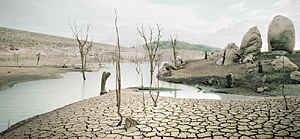
Drought revealed the skeletons of trees once covered by Lake Hume, a massive manmade reservoir bordering the states of New South Wales and Victoria.
If what Australia is experiencing is not global warming, it's something that looks just like it.
The driest inhabited continent has just endured its warmest decade on record and its worst drought in history. It's finally started raining again, but not before the 10-year "Big Dry" cost a quarter of all farm jobs. Most state capitals are turning to desalinating seawater, and severe water restrictions will remain a fact of city life. Water your garden in the middle of the day in Brisbane and you risk a AUS$200 fine; wash your car with potable city water in Melbourne and you'll pay more than twice that.
Drought is just the start of Australia's torments, which also include floods, cyclones, and dust storms.
Hundred-year weather events seem to happen all the time now. Few openly link climate change to the 173 deaths in the Black Saturday bushfires of early 2009, but they are a horrible taste of what's coming. Firefighters point to longer and more intense fire seasons, and scientists warn of a doubling or even trebling of extreme fire-weather days. In the wake of Black Saturday, a new level was added to the nation's fire-danger rating system: catastrophic.
Australia is feeling the effects of climate change--and fueling them as well. It's by far the world's leading coal exporter, shipping out 290 million tons of coal a year from 120 inland mines, out of sight and out of mind for most Australians. The four companies that dominate the global coal trade--BHP Billiton, Xstrata, Anglo, and Rio Tinto--all have corporate offices in eastern Australia, as well as their largest coal-export investments. The coal rush down under also has lured the world's two largest coal-mining companies, the U.S.-based Peabody and the China-based Shenhua. The government plans to let exports double in the next 10 years; by 2020, Australia will ship out as much carbon dioxide through coal as Saudi Arabia does today through oil.

Last year's extreme weather events in Australia were capped by a mammoth dust storm that engulfed half of New South Wales and shrouded Sydney (above) in red dust.
Not long ago the Australian economy was said to ride on the sheep's back. Now coal exports outnumber wool exports by 600 tons to 1, and most believe the economy rides a coal train. Coal is Australia's biggest export, the centerpiece of a natural-resources sector partly credited with shielding the country from the global recession. Eighty percent of Australian coal is burned offshore--mainly in power plants and steel mills in Japan, South Korea, and Taiwan, but increasingly in China and India too. These coal-importing countries are the addicts, with booming economies based on the polluting fuel. Australia is their enabler.
Australians unwilling to see the irony of the situation sometimes have it forced on them. In 2007, cyclonic winds washed a coal tanker up on an iconic surf beach in New South Wales. Greenpeace seized the moment, projecting the words COAL CAUSES CLIMATE CHAOS onto the beleaguered ship's hull. In Queensland a 500-year flood in 2008 submerged large open-pit coal mines, contaminating the Fitzroy River.
As striking as those images were, and as shocking as it is to most Australians to learn that coral bleaching will likely destroy the Great Barrier Reef within their lifetime, only a small handful of activists connect the coal-export industry with the climate change Australia is feeling. There is no Aussie counterpart, for example, to the Sierra Club's Beyond Coal movement. Not one coal-fired power plant here has been closed to reduce greenhouse-gas emissions. On the contrary, previously decommissioned 1960s-era plants are being refurbished, and the coal industry flourishes with bipartisan political support.
That includes the Labor government of Prime Minister Kevin Rudd, which has enthusiastically backed the doubling of Australia's coal exports. Coal, Rudd has declared, is "the backbone of regional Australia." The emissions-trading scheme he proposes is cloaked in the rhetoric of low-carbon economic transformation, but guarantees the future primacy of coal. No matter what reduction target Australia eventually accepts, its most-coal-dependent industries will get, on average, more than 80 percent of their emission permits for free, with no overall cap on their emissions or share of permits.
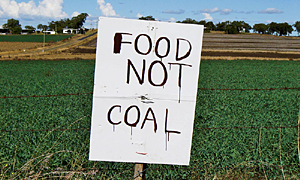
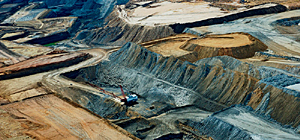 Much of the opposition to coal comes from farmers fearful of encroaching open pit coal mines like this one (below) in central Queensland.
Much of the opposition to coal comes from farmers fearful of encroaching open pit coal mines like this one (below) in central Queensland.
The government openly acknowledges that emissions from these sectors will increase, and modeling released by the federal treasury suggests that even with Rudd's "Carbon Pollution Reduction" scheme, actual emissions in 2020 will be higher than today's. And conveniently, the 80 percent of Australian coal burned overseas is excluded from Australia's emission targets.
Australia is attempting to reconcile its spiraling industrial emissions with its emissions-reduction commitments by buying cheap international carbon credits on a grand scale. It's also seeking a change in international greenhouse-gas accounting rules so it can offload rapidly increasing carbon emissions from wildfires and drought as "natural disturbances." And it wants credit for the huge amount of carbon that can potentially be sequestered in its soil, which may let the country avoid industrial emission cuts for another decade.
Ironically, the rest of the world views Rudd as an ecofriendly politician who ratified the Kyoto Protocol, championed an ambitious global climate agreement, and vowed to set a national target of lowering greenhouse emissions by up to 25 percent by 2020. Barack Obama said Rudd was doing "a terrific job," and Al Gore twice toured with him, heaping praise and recording a video for the prime minister's Web site. Gore did distance himself from Rudd's polluter-friendly emissions-trading scheme ("not what I would have written"), but the overall impression has been a glowing endorsement of the Australian government.
Rudd, at least, acknowledges that global warming is a problem. The other side of Australian politics is thoroughly controlled by climate skeptics. When "moderate" elements of the conservative opposition negotiated concessions from Rudd to make the proposed emissions-trading scheme even more polluter friendly, conservatives changed their leader rather than see it enacted. Their new leader, Tony Abbott, calls the scientific case for human-made global warming "absolute crap."
The most conspicuous resistance to the Australian coal rush comes from farmers. It's not that they link coal and climate change to the devastating drought (although scientists expect irrigated agriculture in the Murray-Darling Basin, the most significant agricultural area, to be gone by 2100). Rather, coal mining and coal-bed methane extraction directly threaten the country's 6 percent of arable land. In particular, farmers fear the mining could damage the headwaters and aquifers feeding into the Murray-Darling river system. The battle pits two of the country's most potent lobbying forces against each other.
Rosemary Nankivell is one of hundreds of farmers whose outlook has been turned upside down. Since 1920, her family has farmed 5,000 acres of some of Australia's best land, in the Liverpool Plains region of northwest New South Wales. Now she sees the devastation that coal mining has inflicted on farms in the neighboring Hunter Valley unfolding on her own doorstep: "We're seeing the same divide-and-conquer strategy used to buy up farms, and we're hearing the same hollow rhetoric about mining and farming coexisting peacefully and about mining not harming the rivers and groundwater. In truth, these companies don't care about the devastation they leave behind."
The farmers have attracted influential backing. The conservative National Party's senate leader, Barnaby Joyce, for example, says, "There are certain peculiar areas in Australia where the quality of the land is so exceptional that you should not be compromising that for coal." Yet Joyce is also a prominent greenhouse-gas skeptic and a supporter of coal mining; in 2006 he suggested that Australia should mine coal in Antarctica before others get to it.
A few well-connected farming communities may prevail in preserving their land, but it will scarcely dent Australia's booming coal industry. Most transactions involve drought-weary farmers who can feel the climate changing, whether or not they blame human activity. As Nankivell puts it, "If someone is offered a million dollars for 500 acres of marginal country, they're quietly taking the money."
Perhaps as a subtle hint to would-be sellers, BHP Billiton, Xstrata, and others are sponsoring a "drought recovery concert" by the Sydney Symphony Orchestra. "BHP Billiton brings soothing Symphony to drought-stricken farmers," croons the press release. As greenhouse gases slowly broil Australia's parched farms, the band plays on.
ON THE WEB See more photos from award-winning photographer Michael Hall.
Guy Pearse is a research fellow at the University of Queensland's Global Change Institute.
These articles were funded by the Sierra Club's Beyond Coal campaign.
China photos, from top: Natalie Behring/Aurora Photos; Andrew Wheeler/Alamy; Natalie Behring/PANOS;
Australia photos, from top: Michael Hall; Christophe Launay/Aurora Photos; Friends of Felton; Doug Steley B/Alamy